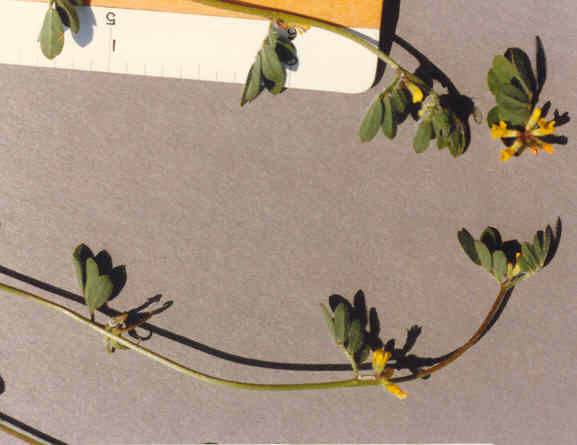
Lotus hamatus Greene
=Hosackia micrantha
Fabaceae (Pea Family)
Native
San Diego Lotus
San Diego Hosackia
 |
Lotus hamatus Greene=Hosackia micranthaFabaceae (Pea Family)NativeSan Diego LotusSan Diego Hosackia
|
April Photo
Plant Characteristics:
Annual, prostrate with many branches arising from the crown of the root; young
stems, leaves and calyces appressed-pubescent; lfts. 4-6, oblanceolate, often
mucronate and cuneate; umbels sessile or nearly so, bractless; fls. 3-4.5 mm.
long, the calyx half as long; calyx teeth subulate, shorter than the tube;
banner shorter than the keel; legumes several times as long as the calyx,
slender, arcuate, constricted between the two seeds, as pod leaves calyx it
makes a 90 degree bend; wall of the fruit with wavy v-shaped markings, beak
curled, strigose.
Habitat:
Dry slopes below 5000 ft.; Coastal Sage Scrub, Chaparral; n. L. Calif. to
San Luis Obispo Co. March-June.
Name:
Greek, lotos, a sweet,
juicy-fruited shrub; also the name of several other plants.
Hamatus, hooked.
(Jaeger 115,144). The species name refers to the hooked legumes.
General:
Uncommon in the study area having only been found on the 23rd St. bluffs
and on the bench northerly of and above 23rd St.. (my comment).
In the southwestern United States, the larvae of the Marine Blue butterfly, Leptotes
marina, feed on legumes such as lotus, alfalfa and sweet pea in the
wild; often on leadwort, the Plumbago family, in urban areas.
(No author, sbnature, A Journal of the Santa Barbara Museum of Natural
History. Spring 2004/Vol. 2 No. 1, 6-8).
Perhaps 150 species of all continents; but mostly of Northern Hemisphere.
(Munz, Flora So. Calif. 444).
Text Ref:
Jepson 555; Hickman, Ed. 619; Munz, Flora
So. Calif. 447.
Photo Ref:
April-May 86 # 12,13.
Identity: by R. De Ruff,
confirmed by F. Roberts.
First Found: April 1986.
Computer Ref: Plant Data 104
Have plant specimen.
Last edit 10/18/04.